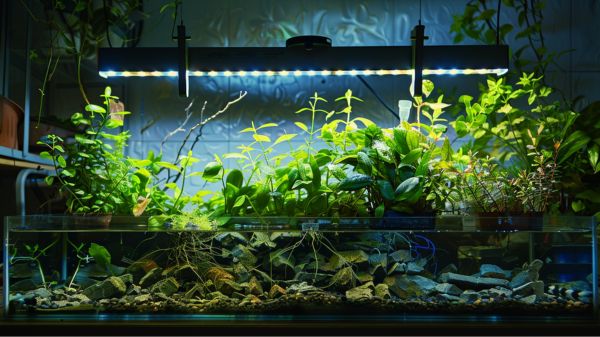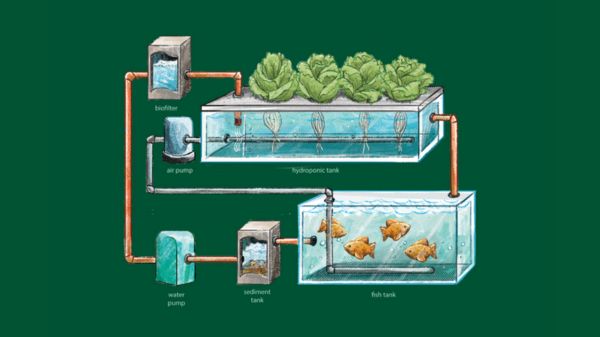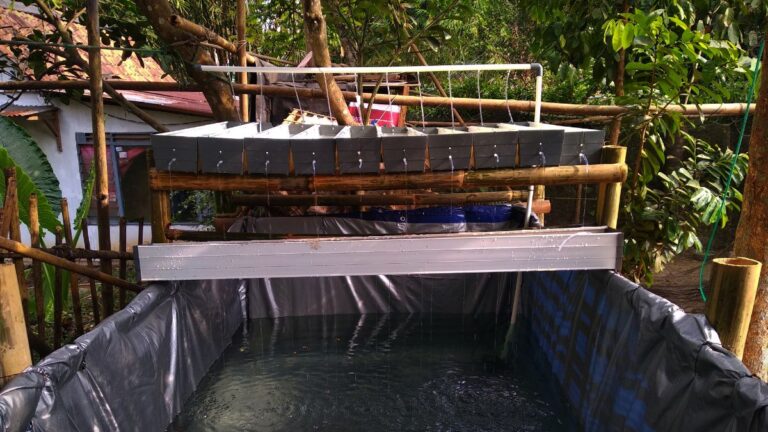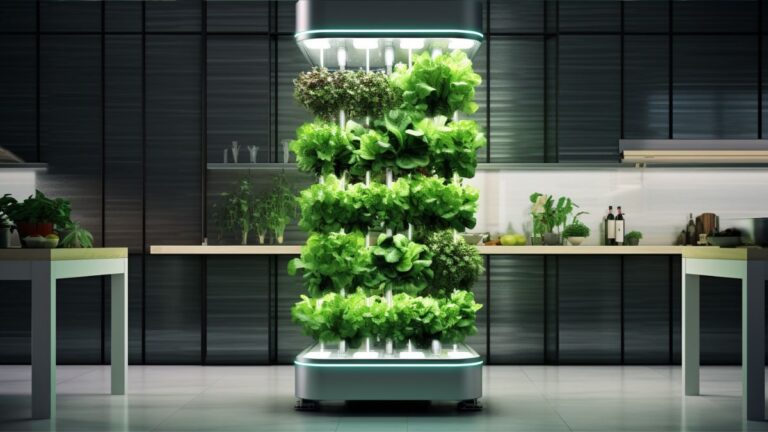10 Essential Lighting Tips for Your Indoor Aquaponics System
When it comes to optimizing the growth of plants in your indoor aquaponics system, lighting plays a pivotal role. Ensuring that your plants receive the right amount and type of light is essential for their overall health and productivity.
From understanding the specific light requirements of different plant stages to selecting energy-efficient lighting options, there are key tips that can elevate your aquaponics setup to new heights. By following these expert suggestions, you can create an ideal environment for your plants to thrive and flourish.
Key Takeaways
- Balance light spectrum for plant growth stages and fish health.
- Maintain optimal light levels to prevent growth issues.
- Consider lighting duration and timing for plant rest and growth.
- Use light management techniques for efficient and effective indoor aquaponics.
Understanding Plant Light Requirements
Understanding the intricate nuances of plant light requirements is essential for cultivating thriving indoor aquaponics ecosystems. Plants rely on light not only for photosynthesis but also for regulating their growth patterns.
When it comes to indoor aquaponics system, providing the right light spectrum is critical. Plants primarily absorb red and blue spectrum light for different stages of growth. Blue spectrum light, for instance, is essential for promoting vegetative growth, while red spectrum light encourages flowering and fruiting.
Inadequate light exposure can lead to issues such as leggy growth or plants leaning towards light sources in search of more energy. It is essential to take into account the specific light requirements of different plant species when setting up lighting in aquaponics systems.
Additionally, understanding the light needs of the fish species in the ecosystem is equally important, as excessive light can stress them. Through trial and error, aquaponics enthusiasts can fine-tune the lighting intensity and duration to create an ideal environment for both plants and fish.
Importance of Balanced Light Spectrum
A balanced light spectrum is essential for an indoor aquaponics system as it guarantees plants receive the necessary wavelengths for growth. Blue light stimulates vegetative development, while red light encourages flowering and fruiting.
Spectrum Balance Importance
Achieving a balanced light spectrum is paramount for ensuring the prime growth and development of plants within indoor aquaponics systems. The light spectrum, particularly the balance between blue and red wavelengths, plays a critical role in promoting prime plant growth.
Blue light is essential for stimulating vegetative growth, influencing processes like photosynthesis and chlorophyll production. On the other hand, red light is important for encouraging flowering and fruiting stages in plants, important for overall plant development.
A well-calibrated mix of these wavelengths, along with other light spectrums, guarantees that plants receive the necessary light energy for their various growth stages. Imbalances or deficiencies in the light spectrum can result in stunted growth, lower yields, and overall unhealthy plants, highlighting the importance of maintaining a harmonious light spectrum for indoor aquaponics success.
Optimal Light Levels
Maintaining ideal light levels in an indoor aquaponics system is essential for ensuring a balanced light spectrum, which is critical for promoting healthy plant growth and development. The light spectrum plays a pivotal role in providing the necessary wavelengths for photosynthesis, a key process for plant growth.
Different plant stages require specific light levels to thrive effectively, making it important to adjust the light intensity accordingly. By ensuring the right balance of light spectrum, you can prevent issues such as leggy growth or stunted development in plants.
A well-balanced light spectrum not only supports plant growth but also contributes to the overall health and productivity of both plants and fish in aquaponics setups. Proper light levels are fundamental for achieving the best results in indoor aquaponics systems.
Consider Lighting Duration and Timing
In an indoor aquaponics system, understanding the importance of the light cycle, best light duration, and precise timing for plant growth is essential for maximizing yields.
Plants require a specific amount of light exposure to thrive, with 12 to 16 hours of sunlight being the ideal range. Balancing this with adequate darkness intervals, typically around 8 hours, supports the plants’ natural growth rhythms and overall health.
Light Cycle Importance
To optimize plant growth and health in indoor aquaponics systems, ensuring an appropriate light cycle with specific consideration for lighting duration and timing is paramount.
- Consistent light cycle of 12 to 16 hours daily promotes best growth.
- Providing at least 8 hours of darkness per day allows plants to rest and photosynthesize effectively.
- Prevent issues like limp leaves or uneven growth by maintaining the right light cycle.
- Different growth stages require specific lighting durations and timing for best results.
Monitoring and adjusting the light cycle based on plant response is essential for healthy growth and maximum productivity in indoor aquaponics setups. By understanding the importance of the light cycle, aquaponic enthusiasts can create an ideal environment for their plants to thrive.
Optimal Light Duration
For essential growth and development of plants in indoor aquaponics systems, it is crucial to carefully consider the duration and timing of lighting to guarantee maximum productivity and health.
The light duration plays a vital role in the process of photosynthesis, which is the lifeblood of plant growth in indoor aquaponics setups. Typically, plants require 12 to 16 hours of sunlight daily to thrive optimally. Adequate darkness, about 8 hours, is equally important as it supports their health and development.
Finding the right balance in light duration is key to avoiding issues such as limp leaves or uneven growth patterns. Through trial and error, growers can determine the ideal light duration tailored to the specific needs of various plant species in indoor aquaponics environments.
Timing for Plant Growth
Achieving peak plant growth and productivity in indoor aquaponics systems hinges on meticulously coordinating the timing of lighting duration and intensity to meet the specific needs of different plant species. Proper timing of light exposure is essential to avoid issues like limp leaves or thin, uneven growth.
To optimize plant growth, consider the following:
- Light Spectrum: Understanding the importance of red and blue light wavelengths in stimulating plant growth.
- Light Timing: Providing 12 to 16 hours of sunlight daily for best growth, while allowing at least 8 hours of darkness for plants to rest and recover.
- Specific Needs: Different plant growth stages require tailored lighting durations and timing for maximum productivity.
- Success Factors: Comprehending the lighting needs of plants is key to successful growth and bountiful harvests.
Position Lights for Optimal Coverage
Positioning grow lights in an overhead configuration is essential to guarantee uniform coverage over the entire plant canopy in indoor aquaponics systems. When positioning the lights, it is important to take into account the light spectrum emitted by the fixtures, making sure it meets the specific needs of the plants being grown.
Adjusting the light height is essential to maintain an ideal distance of 12-18 inches above the plants, as this range facilitates efficient light distribution across the canopy. Additionally, incorporating reflective materials around the grow area can greatly enhance light penetration and minimize shadows, further maximizing the effectiveness of the lighting setup.
To achieve ideal coverage, it is advisable to take into account the light footprint of each fixture to prevent overlapping or leaving gaps in coverage, which could lead to uneven light distribution. Regularly monitoring and adjusting the positioning of the lights as the plants grow is important to make sure that all areas receive adequate light for healthy development.
Monitor and Adjust Light Intensity
To guarantee maximum plant growth in your indoor aquaponics system, monitoring and adjusting light intensity levels is essential. Utilize a light meter to measure the intensity and make necessary height adjustments to maintain ideal lighting conditions.
Light Intensity Levels
Monitoring and adjusting light intensity levels is a critical aspect of maintaining prime conditions for plant growth in indoor aquaponics systems. To guarantee ideal growth, follow these key steps:
- Utilize a light meter to accurately measure light intensity levels.
- Adjust the height of grow lights accordingly to meet the specific needs of your plants.
- Insufficient light intensity can result in leggy growth, while excessive light may cause leaf burn.
- Proper light intensity is essential for supporting photosynthesis, plant development, and maximizing system productivity.
Optimal Lighting Conditions
For best growth and development of plants in indoor aquaponics systems, making sure that light intensity levels are carefully monitored and adjusted is paramount.
Use a light meter to measure the light intensity and guarantee it falls within the ideal spectrum for plant growth. Adjust the height of the light fixtures to maintain the recommended distance between the light source and plants, preventing issues such as light burn or insufficient light exposure.
By regulating the duration of light exposure with a timer, plants can receive the necessary amount of light each day. Additionally, rotate plants regularly to promote uniform growth and address any signs of light stress promptly.
Monitoring and adjusting light intensity are key factors in creating ideal lighting conditions for indoor aquaponics systems.
Adjusting Light for Growth
Regular monitoring and adjustment of light intensity is critical for optimizing plant growth in indoor aquaponics systems. To guarantee your plants thrive, ponder the following tips:
- Monitor plant growth regularly to assess light sufficiency for photosynthesis and development.
- Adjust light intensity by moving grow lights closer or further away from plants as needed.
- Use a light meter to measure and maintain light levels within the recommended range for different plant stages.
- Experiment with light duration and intensity to find the perfect balance for maximum plant productivity.
Remember to contemplate supplemental lighting during darker seasons or in areas with limited natural light to sustain plant health.
Ensure Proper Light Distance
To optimize plant growth and prevent light burn, maintaining a consistent distance of 12-18 inches between grow lights and plants is essential in indoor aquaponics systems. This distance guarantees that light intensity is sufficient for photosynthesis without causing damage to the plants.
As plants grow, it is important to adjust the light distance to guarantee ideal coverage and intensity across all plants in the system. Consider the light spread and angle to evenly illuminate all plants, preventing any from being shaded or receiving too much direct light.
Using a light meter can help measure the light intensity at different points within the system, allowing for precise adjustments to the light distance. Proper light distance not only prevents stretching and light burn but also promotes compact growth and maximizes photosynthetic activity, ultimately leading to healthier and more productive plants in your indoor aquaponics setup.
Choose Energy-Efficient Lighting Options
Selecting energy-efficient lighting options is essential for maximizing cost savings and promoting sustainable practices in indoor aquaponics systems. When choosing lighting for your setup, consider the following benefits of energy-efficient options:
- LED Efficiency: LED grow lights are highly energy-efficient, consuming less electricity compared to traditional lighting options.
- Cost Reduction: Energy-efficient lighting choices like LEDs can help reduce overall operating costs in indoor aquaponics systems.
- Heat Management: LEDs produce minimal heat, ensuring a stable temperature environment for plants in indoor setups.
- Sustainability: Opting for energy-efficient lighting solutions contributes to sustainability and eco-friendly practices in aquaponics.
Maintain Clean Light Fixtures Regularly
A key aspect of ensuring ideal lighting performance in indoor aquaponics systems is through regular cleaning of light fixtures to prevent dust and dirt buildup, which can hinder light intensity and impact plant growth.
Dust and debris accumulation on grow lights can block the light output, reducing the amount of light reaching the plants and affecting their photosynthesis process. Regular maintenance of light fixtures is essential to ensure perfect light distribution and coverage for all plants in the setup.
Additionally, keeping the fixtures clean helps prevent potential pest infestations in your indoor aquaponics system, as pests are attracted to dirty and neglected areas. It is also vital to clean the fixtures to maintain their efficiency and longevity, as dirt buildup can cause overheating issues, especially in setups where multiple lights are daisy-chained, generating a lot of heat.
Consider Light Durability for Longevity
Consideration of the durability of grow lights is paramount in ensuring their longevity and best performance in indoor aquaponics systems. When selecting lighting for your aquaponics setup, it is essential to prioritize durability to maximize the lifespan of your investment. Here are some key points to take into account:
- LED Technology: Opt for LED grow lights known for their durability and long lifespan, lasting up to 50,000 hours of continuous use.
- Quality Components: Choose grow lights with high-quality components and materials to guarantee resilience against wear and tear, allowing them to produce a lot of light over time.
- Construction: Look for grow lights with sturdy construction and effective heat dissipation features to maintain excellent performance, which is a good thing for your plants.
- Protection: Take into account grow lights with waterproof and dustproof ratings to safeguard them against environmental factors, ensuring consistent light output for plant growth.
Invest in Quality Lighting Equipment
To optimize plant growth and yield in indoor aquaponics systems, prioritizing the acquisition of high-quality lighting equipment is essential. Quality lighting equipment, such as LED grow lights, plays a vital role in enhancing plant development by providing the necessary light spectrum customization and intensity for different growth stages.
LED grow lights, known for being energy-efficient, offer cost-effective solutions while allowing for precise customization of light spectrum and intensity to meet the specific needs of plants. Brands like VIPARSPECTRA or BESTVA LED grow lights are recognized for their ability to deliver full spectrum lighting, promoting the best plant growth and development in indoor aquaponics setups.
Selecting the right lighting equipment is paramount in creating an environment conducive to plant growth optimization, ensuring that plants receive the appropriate light spectrum and intensity for their overall health and productivity. By investing in quality lighting equipment, aquaponic enthusiasts can establish an efficient and effective indoor growing environment that supports thriving plant ecosystems.
Related Post: Aquaponics System: A Complete Guide for Beginners.
Conclusion
In summary, ensuring proper lighting in your indoor aquaponics system is essential for promoting healthy plant growth and maximizing productivity. By understanding plant light requirements, balancing light spectrum, monitoring intensity, and choosing energy-efficient options, growers can create an ideal environment for their crops.
Investing in quality lighting equipment and maintaining fixtures regularly will contribute to the longevity and success of the aquaponics setup. Overall, attention to lighting details is critical for achieving sustainable and efficient indoor plant cultivation.







